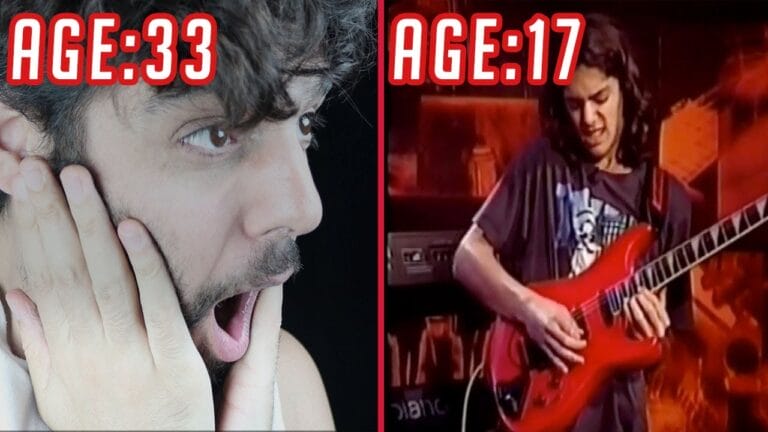JAZZ Guitar Comping Essentials
Here’s what’s about to happen. Well, when it comes to jazz chords, we all kind of tend to agree that shell voicings are the most basic ones to use. If you don’t know what shell voicings are yet, don’t worry because I’m about to briefly explain before we jump into these pretty basic yet very important exercises. We want to take each one of these exercises and be able to apply them to as many tunes as we can before we can become very natural in comping. Once you learn all these exercises, re-watch this video to take these exercises and apply them on your own favorite suggestions.
Shell Voicings
Basic Understanding
First thing you need to understand: usually, chords are built out of a root, a third, and a fifth. Right? For example, if I’m in C major, I can see C is the root, E is our third, and G is our fifth. But we’re talking about shell voicings. The most common chords we’re just talking about the fundamental sounds of the root, third, and seven. So instead of having this fifth over here, G, we’re going to change it to a 7, a major 7, so we get this major 7 sound.
So that’s a very common shell voicing which we can also do on this set of strings and also this set of strings. Now you can do the same thing with dominant chords. Instead of having a major 7, you can have a 7 over here which would look like that over here and then on this set it will look like that.
Minor Chords
Now what we’re going to do is apply this also on minor chords. We’re going to have an F minor, for example. So instead of having this F minor triad, we’re going to replace the 5 with a 7, so we get this:
[Music]
Okay, here it is over here and here it is over here.
Open vs Closed Voicings
In shell voicing, it’s important to understand like in any chord, there’s a closed version and an open version. Let me show you what I mean. Well, our song is going to be in B flat, right? So if I look at this B flat triad and I make it a shell voicing by replacing the five with the major seven:
Open vs Closed
I get this one, three, seven. I can take the second note over here, which is the third, and put it up, and I get a more open kind of version of that shell voicing. So:
- Closed
- Open
- Closed
- Open
Let’s do it over here. Here’s a close shell voicing with exact same notes, exact same formula. I’m going to take the second note here, D, and put it up.
[Music]
Now I have an open shell voicing.
Exercise 1: Cherokee Changes
So closed and open. Okay, so now what I’m going to do is I’m going to play both a combination of closed and open shell voicings just to play the chords of “Cherokee” and that’s how it’s going to sound.
[Music]
Exercise 2: Higher Register
In this next example, I’m going to do the same exact thing. I’m just going for a higher register. So I’m gonna start over here from this B flat closed shell voicing and combine open and close shell voicing as I go.
[Music]
Color and Tension
You can add tensions to those chords. So let’s say we’re playing the B flat major seven. We can add the nine to the chord. So this is going to be the nine right over here:
[Music]
You can do that or we can do an open version and then add the nine over here. Same goes for F. You can add a 9 over here. When we’re talking about dominant chords, we can basically almost add anything we want and it’s very popular to add a 13 or a flat 13, or a 9 or a flat 9, or we can add a sharp 9, especially when talking about the closed sound.
Shared Voicings
Here’s the one, three, seven. Here’s the sharp nine. Here it is an octave up.
So you can use all these kinds of sounds to start playing ideas within your chords while you’re comping. So I’m just going to improvise a short example.
Comping Improvisation Demonstration
[Music]
Rootless Chords
You don’t need to include the root every time, especially when you’re starting to add notes to your chords. For example, you know, if I see this B flat major 7 and I’m adding a 9, these three notes over here are enough sound, especially when you have a bass player for me to complete. Right? Or if I’m talking about F minor and I’m adding an 11 over here, I can just take the root out and I have this beautiful sound over here.
Right?
If I’m talking about B flat and I’m adding a flat nine, I can take the root out. I have this beautiful diminished sound over here or I can go to the sharp nine and also:
[Music]
Exercise 5: 2-Note Comping
Another thing that I can do is not even play an entire chord or you can just use the third and the seven. Try that out here to go.
[Music]
Exercise 6: 2-Note Comping (3 & 7)
[Music]
Exercise 7: 2-Note Comping (3, 7, and Others)
So that’s it for now. Please make sure to subscribe and like this video. Also, drop me a comment; that really helps. If you really want to go deeper into these kinds of subjects and really get a solid understanding of the fretboard, also learn some jazz language, check out my 51 Galactic Jazz Licks and Galactic Modern Guitar courses. What would you like my next lesson to be about? Let me know in the comments below. See you in the next video.
[Music]
Here’s a detailed lesson on basic jazz guitar comping for intermediate players (including an introduction to shell voicings) Adding tension, creating melodies, rootless chords, and 2 note comping.
▬ Contents of video ▬▬▬▬▬▬▬▬▬▬
0:00 Here’s what’s about to happen
0:29 Shell Voicings open/closed
01:00 Make sure you know these
01:14 These 7 dominant chords as well
02:10 open vs closed
02:40 EX1 (Cherokee Changes)
03:14 EX2 Higher register
03:50 Color and tension
04:59 Comping Improvisation demonstration
05:20 Rootless chords
06:15 Ex5 2note comping
06:35 Less can be more!
06:44 Ex6 2note comping (3&7)
07:03 Ex7 2note comping (3,7, and others)



















